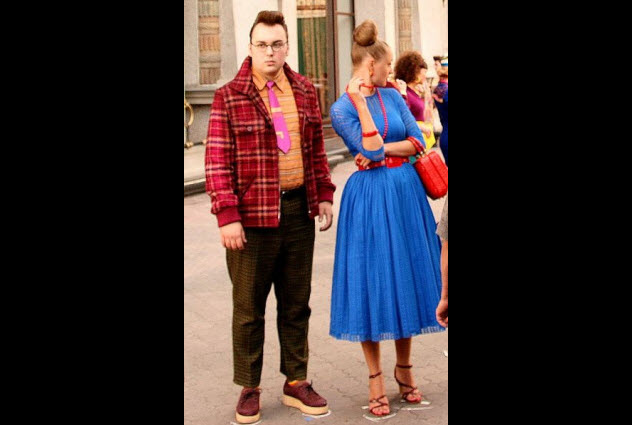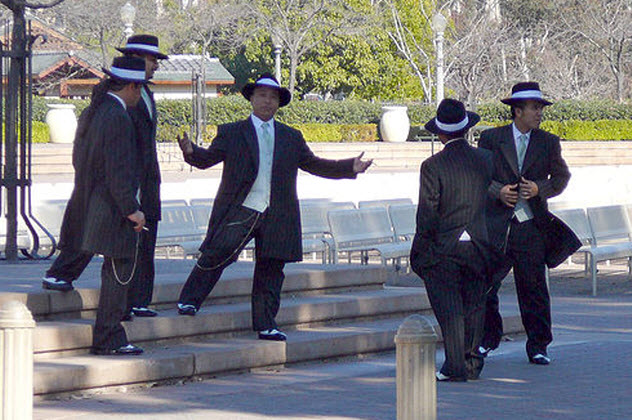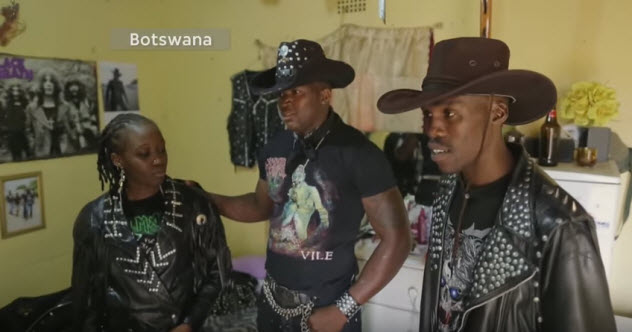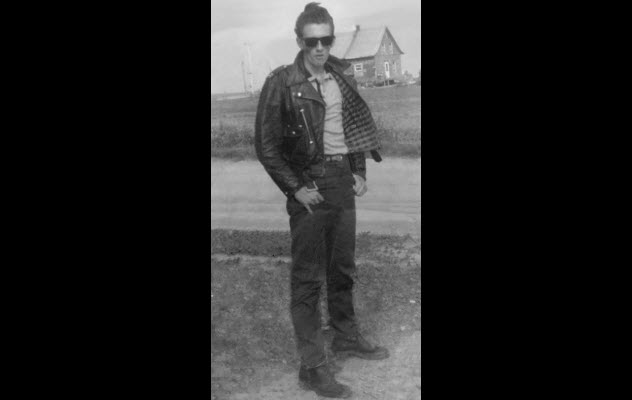 Weird Stuff
Weird Stuff  Weird Stuff
Weird Stuff  Our World
Our World 10 Ways Your Christmas Tree Is More Lit Than You Think
 Movies and TV
Movies and TV The 10 Coolest Stars to Set Sail on The Love Boat
 History
History 10 Things You Didn’t Know About the American National Anthem
 Technology
Technology Top 10 Everyday Tech Buzzwords That Hide a Darker Past
 Humans
Humans 10 Everyday Human Behaviors That Are Actually Survival Instincts
 Animals
Animals 10 Animals That Humiliated and Harmed Historical Leaders
 History
History 10 Most Influential Protests in Modern History
 Creepy
Creepy 10 More Representations of Death from Myth, Legend, and Folktale
 Technology
Technology 10 Scientific Breakthroughs of 2025 That’ll Change Everything
 Weird Stuff
Weird Stuff Ten Bizarre Facts About The Doge Meme
 Our World
Our World 10 Ways Your Christmas Tree Is More Lit Than You Think
 Movies and TV
Movies and TV The 10 Coolest Stars to Set Sail on The Love Boat
Who's Behind Listverse?

Jamie Frater
Head Editor
Jamie founded Listverse due to an insatiable desire to share fascinating, obscure, and bizarre facts. He has been a guest speaker on numerous national radio and television stations and is a five time published author.
More About Us History
History 10 Things You Didn’t Know About the American National Anthem
 Technology
Technology Top 10 Everyday Tech Buzzwords That Hide a Darker Past
 Humans
Humans 10 Everyday Human Behaviors That Are Actually Survival Instincts
 Animals
Animals 10 Animals That Humiliated and Harmed Historical Leaders
 History
History 10 Most Influential Protests in Modern History
 Creepy
Creepy 10 More Representations of Death from Myth, Legend, and Folktale
 Technology
Technology 10 Scientific Breakthroughs of 2025 That’ll Change Everything
10 Cool Subcultures You’ll Want To Join
Within every culture, there are various subcultures just waiting to be recognized and appreciated by a curious onlooker. Some of these subcultures can be rather unusual and perhaps even threatening, while others seem completely normal and ordinary.
10 Russian Stilyagi

In the 1950s, Moscow’s stilyagi (“hipsters”) were teenagers who wore modern haircuts, daring makeup, and brightly colored Western clothes despite the heavy cultural repression of the USSR. In secret, they listened to strictly forbidden American jazz and rock music. Their belief in freedom of expression was so fervent that they were willing to risk being arrested by the Russian police, who organized daily roundups.
Since it was hard to find vinyl in the Soviet Union, the stilyagi rescued discarded X-rays from hospital wastebins. Then they cut the vinyl into crude circles and burned cigarette holes in the middle. A copy of a Western record album was etched into each vinyl circle, resulting in homemade records that were known as bone music.
The quality was poor, and they could be played on one side only. But they were cheap to make and did the job. These homemade records often contained surprises within them, such as a mocking Russian voice saying, “So, thought you’d take a listen to the latest sounds, eh?”
Eventually, an underground network of bone music record distributors popped up across the Soviet Union. Known as the X-ray press, this network distributed millions of Western records throughout the USSR. However, this method of distribution was soon noticed by the authorities, who attempted to stamp it out. Official groups known as music patrols hunted down distributors and confiscated the records.
9 Teddy Boys
Often, it is falsely believed that the teddy boy phenomenon began as a side effect of the rock ‘n’ roll revolution of the mid-1950s. However, it is most likely that this subculture was started by a Savile Row tailor in Britain in the late 1940s to revive the style of the Edwardian dandy.
British youths were soon inspired by this new movement. Rejecting postwar grayness and austerity, they embraced this eccentric fashion instead. These “teddies”—a name coined in 1953 when a headline in the Daily Express newspaper shortened the word “Edwardian” to “Teddy”—wore drape jackets, brocade waistcoats, drainpipe trousers, white shirts with high necks and loose collars, and slim ties. The clothes were of excellent quality and mostly tailor-made, which the teddy boys paid for in weekly installments.
Their hairstyles were also distinctive, further setting them apart from the crowd. They wore a heavily greased quiff in the front and a flattened style known as a duck’s arse in the back.
The teddy boys received plenty of worried glances. Gradually, they became unwelcome in society because they were involved in certain violent events, including the stabbing death of a 17-year-old boy at the hands of the Plough Gang, who dressed in Edwardian suits. Signs which read “No Edwardian clothes or rubber-soled footwear” began to appear in local dance halls.
The teddy boy subculture persevered but with fewer members. In the 1970s, they began to merge with “rockers.” It became common to see teddy boys wearing leather jackets during the daytime but drape jackets and collared shirts at night.
8 Neo Pinup Girls
Borrowed from the 1940s and ’50s, the look of the retro pinup girl has once again gained momentum. It was first made popular by women like Marilyn Monroe and Bettie Page, who were known for their feminine curves and glamorous style as well as for their classic makeup and immaculate hairstyles. The pinup movement was revived in the 1990s by women like Dita Von Teese and Sabina Kelley.
This has evolved into a new subculture known as neo pinup. Members of this subculture still channel the glamour of the 1950s but add a modern twist to their overall style. Personality and quirks are important to these neo pinups. They often sport brightly colored hair, piercings, and even tattoos. They may use modern fabrics, such as latex, but still opt for the vintage cut and style.
7 Pachucos

Pachucos were a subculture of Mexican-American men and women from the 1930s to the 1950s who dressed in zoot suits or similar types of clothing. Zoot suits had broad-shouldered sport coats and baggy trousers which were cuffed tightly at the ankles and worn high on the waist. The coats usually had a key chain hanging from the pocket. The pachucos often wore ducktail hairstyles and accessorized with felt hats, tattoos, and sometimes even a concealed weapon.
The women, known as pachucas, wore men’s jackets, short skirts, fishnet stockings, and platform heels. Their hair was piled high, and they wore lots of makeup, especially lipstick. Some pachucas wore men’s zoot suits and engaged in recreational activities, such as smoking in public, which seemed rather masculine at the time.
In 1942, when the War Production Board tried to limit fabric consumption for suits, pachucos ignored these regulations and acquired their suits through bootleg tailors, which caused quite a scandal in wartime America.
Pachucos often spoke calo, a hybrid language influenced by indigenous languages, the dialect of gypsies, Spanish, and English. As the public grew to resent the pachucos, calo became a language known only to the members of this subculture.
6 Heavy Metal Subculture Of Botswana

In 2008, South African photographer Frank Marshall documented the heavy metal subculture of Botswana by accompanying a South African metal band on a tour of Gaborone, Botswana’s capital. There, he met Botswana’s metalheads, who dressed in the most unusual attire he had ever seen.
Not only did these African men wear metal band T-shirts, they also sported cowboy hats and leather gear adopted from bikers. Their accessories included hunting knives and parts of dead animals, and most of them carried hollowed-out horns of cows from which they drank. Women also took part in this heavy metal movement.
According to Marshall, there is fierce competition between members to see who can look the most brutal. In addition to their intimidating outfits, they often give themselves unusual names such as “Dead Demon Rider” or “Cofinfeeder,” which further enhances their aura of brutality.
Some of Botswana’s biggest metal bands include Skinflint and Amok, although they don’t play often for various reasons. However, when the metal bands do hold their shows, rockers throughout the country attend, even if they have to travel long distances over difficult terrain. They like to listen to the bands and catch up with their fellow metalheads.
5 Greasers

After emerging in the US in the 1950s, greasers grew in popularity in the 1960s. Originally, their name came from the Greaser Act of 1855, which allowed Americans living in California to oppress Mexicans because of their supposedly poor, dangerous nature.
Thus, the name had a negative connotation and suited this subculture rather well because the rest of American society already viewed them as dangerous, violent individuals. However, they also became known as greasers because their greasy hair was always slicked back with various gels and pomades. Often, they carried a comb with them so that they could manage their heavily styled hair at any time.
Greasers wore leather jackets, jeans, black or white T-shirts that were tightly fitted, and motorcycle boots. They loved loud rock music, fast cars, and stripped-down motorcycles. Elvis Presley was their icon.
Women also sported this look by wearing pencil skirts, poodle skirts, or straight-leg jeans with motorcycle jackets. It was a real contrast to the rest of society, especially as America entered a new age of widespread prosperity and strait-laced conformity after World War II.
4 Argentinean Floggers
Floggers were a phenomenon that originated in Argentina at the end of 2004 and then spread to other parts of Latin America, such as Mexico and Venezuela. Originally, the term “flogger” came from a youth movement in which Argentinean teenagers posted photographs of themselves on a photoblog called Fotolog.
This often led to huge numbers of followers and comments. Some posters even received modeling contracts and opportunities to travel. However, there was more to floggers than that. To be a true flogger, you had to adopt a specific style of clothing, hair, and music.
Floggers had a unique sense of fashion. They wore bright colors, tight pants, V-neck T-shirts, and white shoes. They usually wore their hair brushed to one side. Their choice of music was electronica and rock, and their dance moves were inspired by tecktonic music from France.
3 Rude Boys
Rude boys emerged in Jamaica in the years immediately before and after the country gained its independence from Britain in 1962. As Jamaica’s living conditions were poor, riots and protests were part of everyday life. As a result, many people engaged in “scuffling,” which was scrounging to survive by any means possible.
It was in these conditions that the subculture of rude boys was born. Needless to say, they were angry. Their antisocial, violent behavior often made headlines in local newspapers.
Rude boys were known for imitating the attire of the upper classes. They wore close-fitting suits, porkpie hats, and sunglasses. Often, they carried handguns and German ratchet knives. Their gangster image certainly set them apart and rightly caused suspicion. They often created tense situations and then drew their knives first.
Rude boys were known throughout Jamaican society. In 1962, Stranger Cole released the song “Ruff and Tough,” which became the first rude boy anthem. In 1963, Wailers released the single “Simmer Down.” The song was written and sung by Bob Marley at age 18 to appease his mother, who was worried about the rude boy company her son was keeping.
As young Jamaicans immigrated to Great Britain in the 1950s and ’60s, they brought the movement of rude boys with them, which went on to influence subcultures such as mods and skinheads.
2 Sharpies
Sharpies belonged to a youth movement born in Australia. They were most prevalent in the 1960s and ’70s and mainly consisted of young people from the predominantly working-class and migrant suburbs.
Sharpies had specific haircuts and clothes that defined them. The boys usually wore flared, high-waisted pants or jeans with T-shirts or striped cardigans. The girls opted for miniskirts or pleated skirts, cardigans, and wedged high heels.
The cardigan, known as a conny, was the most important piece of clothing in every sharpie’s wardrobe. It was tight, collared, and striped. The stripes came in a wide variety of colors that often clashed. Sometimes, these cardigans had little buttoned belts in the back. As for hairstyles, the mullet was preferred by both boys and girls.
Sharpies were quite territorial and used to name their gangs after the suburbs or streets from which they came. Although they were known to be tough and violent, sharpies mostly fought with rival sharpies or local surfers known as surfies.
Sharpies liked tough, straightforward rock music. Some of their favorite bands included AC/DC and the Skyhooks. Sharpies also had a specific dance which involved forming a circle and bouncing on their legs while pumping their fists in front of their bodies.
1 New Romantics
The New Romantics were a fashion and music movement which started in the 1970s in a London nightclub called Billy’s. At the time, punk rock music was on its way out, and people needed to identify with a new sound.
The David Bowie and Roxy Music nights at Billy’s soon created these new idols. In 1979, the popularity of the club encouraged the organizers to relocate to a larger nightclub called the Blitz, where they hosted private parties every week that helped to shape the movement’s sound and aesthetic.
The Blitz was known for the colorful, bizarre fashion of the clientele. Both men and women liked to dress in androgynous clothes. Men often wore makeup and frilly shirts in the flamboyant style of the English Romantic period. Inspiration was drawn from an eclectic mix of films from the 1970s and the golden age of Hollywood. Access to the Blitz was strictly limited to those with unique, eye-catching styles.
This fashionable club was also known for upbeat synthesizer pop created for dancing. Spandau Ballet was a major band in this new subculture and soon spread the sounds and styles of this movement around the globe.
It wasn’t until almost one year later that the press spotted this new crowd. They instantly gave them nicknames such as “New Dandies,” “Romantic Rebels,” and the “Blitz Kids.” In 1980, the headline “New Romantics” appeared in the music weekly Sounds and publicized the movement.
Laura is a student from Ireland in love with books, writing, coffee, and cats.








